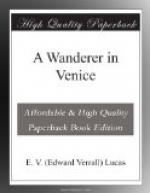Pietro Longhi was born in Venice in 1702, five years after Hogarth was born in London. He died in 1762, two years before Hogarth in Chiswick. I mention the English painter because Longhi is often referred to as the Venetian Hogarth. We have a picture or two by him in the National Gallery. To see him once is to see all his pictures so far as technique goes, but a complete set would form an excellent microcosm of fashionable and frivolous Venice of his day. Hogarth, who no doubt approximates more to the Venetian style of painting than to any other, probably found that influence in the work of Sebastiano Ricci, a Venetian who taught in St. Martin’s Lane.
The brave Tiepolo—Giovanni Battista or Giambattista, as the contraction has it—was born in Venice in 1696, the son of a wealthy merchant and shipowner. In 1721 he married a sister of Guardi, settled down in a house near the bridge of S. Francesco della Vigna, and had nine children. His chief artistic education came from the study of Titian and Paul Veronese, and he quickly became known as the most rapid and intrepid ceiling painter of the time. He worked with tremendous spirit, as one deduces from the the examination of his many frescoes. Tiepolo drew with masterly precision and brio, and his colour can be very sprightly: but one always has the feeling that he had no right to be in a church at all, except possibly to confess.
At the National Gallery we have some small examples of Tiepolo’s work, which, if greatly magnified, would convey an excellent impression of his mural manner. Tiepolo went to Spain in his old age to work for Charles III, and died there in 1770. His widow survived him by nine years, dying in 1779. She seems to have been a gambler, and there is a story of her staking all her losses one evening against her husband’s sketches. Losing, she staked his villa, containing many of his frescoes, and lost again.
Antonio Canal, called Canaletto, was born in Venice in 1697, the son of a scene-painter. At first he too painted scenery, but visiting Rome he was fascinated by its architecture and made many studies of it. On returning to Venice he settled down as a topographical painter and practically reproduced his native city on canvas. He died in 1768. Venice possesses only inferior works from his hands; but No. 474 here—the view of the Scuola of S. Marco—is very fine.
Canaletto had a nephew named Bernardo Bellotto, who to much of his uncle’s skill brought a mellow richness all his own, and since he also took the name of Canaletto, confusion has resulted. He is represented in the Accademia; but Vienna is richest in his work.
The great Canaletto has a special interest for us in that in later life he lived for a while in England and painted here. The National Gallery has views of Eton College and of Ranelagh seen through his Venetian eyes. In Venice Tiepolo often added the figures for him.




